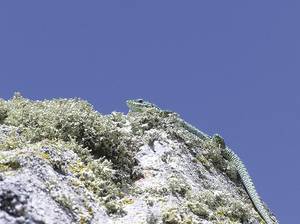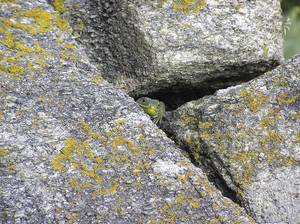Conservative animals, progressive animals

We are clear that individuals in a human population have different personalities. Some individuals are progressive and others more conservative, for example. It is more difficult to explain what happens in other animal species. Therefore, until a few years ago all studies on nature were carried out with man. However, today we know that other animal species also have identities. Just as it happens with people, and even if it seems a lie, animals are also conservative and other progressives against threats, but in the case of animals we use fleeting and bold adjectives (shy-bold). The brave (who would be like progressive men) are willing to face new and challenging situations, while the fleeting (conservative) do not like anything.
To the extent that predation is considered one of the most important selection pressures, in the case of animals it can be an example of explanation of these behavioral variations. Natural selection advocates for specimens that successfully prevent predators, forcing prey to adopt appropriate anti-predatory behavior. However, optimizing the anti-predatory response should be in balance with other needs. A predator may escape, even if the risk is low. Logically, if the threat were not real, it could mean unnecessary metabolic expenditure for the refugee. Therefore, the response to an individual threat is flexible. However, on many occasions, distinctions can be made between species, populations, sexes and people of the same age, as each plays its own way. In addition, these answers are consistent, that is, the same animal acts equally regardless of circumstances. If one animal appears more elusive than another on one occasion (for example, in front of a predator), in others and in other circumstances it will also tend to appear fleeting. When these behavioral differences between the specimens persist in time (not only in response to the current situation), it can be said that there is a personality involved.

This phenomenon can only be explained by genetics and a process of adaptation. Why? Because if it were not so, one of the two trends would have chosen to disappear by natural selection. Think of a specific species of fish. In the same population fleeting and daring animals appear. In the same place dwells also a species of predatory fish of greater size. The brave would not abandon the predators or at least give a later response than the fleeting one. The probability of death of these individuals is higher. Since death has no turning back, this individual will not leave offspring. Therefore, it is to be assumed that natural selection would eliminate from the population exemplary of brave personality.
However, in nature it is observed that the degree of presence of both identities is balanced, since the compensation of both life strategies occurs. Both types of strategies, as a result of an adaptation process, are evolutionarily stable. Let's think again about some individuals of the same fish species and their life strategy. Although the daring are more likely to die, in this short life it can cover more females, as it does not escape - whatever the potential risk. The fugitive will instead be associated with fewer females in the same period of time, but by abandoning predators, their life expectancy is longer. This implies that the successors of a short and long term life are equal, which causes the same fitness (biological efficacy). These life strategies, in addition, will be more effective depending on the environmental conditions and, as these environments can evolve year by year and from place to place, the two personalities are finally optimal depending on the conditions of evolution.

Take as an example Iberolacerta cyreni, a kind of lizard that inhabits the mountains of Madrid. In the heat, the color of the males is blue-green, and in the belly, to attract the females and compete with the others, develop the blue ocelos. The male of I. cyreni is more mature, dominant and healthy the more ocello it has. These dominant males, in a predator-free state, remain active and cover the highest number of females during that time. They also prevent other (non-dominant) males from reproducing with females. However, predators are fleeting, they hide in the dens for a long time. They don't have to risk proliferation. Among those who behave as brave are non-dominant males. After all, their only breeding possibilities are given in periods when males better than they are hidden. These are two life strategies in which individuals presenting the two personalities reproduce equally, so the process of adaptation makes both populations consolidate.
In the case of the human being, it has always been considered that the behavior and way of being of each person is determined by the social environment in which we grow. Today we know, as with other animals, that an important part of the personality of each human being is under the control of genes. Identities and behaviors are characteristics that have been established in the population by natural selection. Therefore, the study of the nature of people in evolutionary terms is no longer the responsibility of classical psychologists, but of evolutionary psychologists (recently formed team of researchers). In recent years there have been many and varied aspects of identity that these experts have analyzed in their research. Topics that until now have not been considered to have a genetic basis have also been addressed. Who could think that an individual's political ideology could depend on genes? There are studies that show that although our political tendency is partly due to social influence, the congenital boom is also of great importance. So is there a genetic predisposition to embrace a certain political ideology? This could explain the perseverance throughout the history of the two great tendencies that appear in different cultures (left/right or liberal/conservative).

The influence of biology on the nature of individuals, however, does not depend only on genes. A study conducted in the US with a group of people of strong political ideology showed that physiology also influences. The individual physical response to sudden noise and threatening images was measured for the study. The results show that conservatives showed a more intense physiological response to threats. These individuals bet on the homeland, the death penalty, the war in Iraq... On the other hand, they are often of low initiative and are more cautious about new phenomena such as immigration. On the contrary, the progressives in favor of the pacifist and the control of arms show a lower physical sensitivity.
Conclusions
It has been a few years since the study of the personality of man and the rest of the animals from the evolutionary point of view. There is still much to be done, but at the moment it can be concluded that the human being and the rest of the animals are more similar than is believed. These similarities also highlight the value of many animal studies and at the same time discourage a large number of people considered absurd. Who can say that personality studies and their current consequences with lizards have no application in humans? Predators would force our ancestors to be brave or elusive. Could it therefore be the evolutionary origin of the struggles between conservatives and progressives today?







